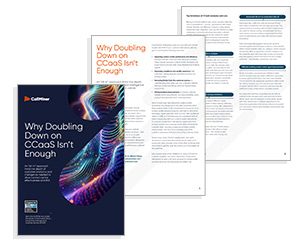Understanding how customers use and feel about the products they buy can ultimately allow companies to make more informed decisions about specific products – whether that’s improving existing products or introducing new ones.
But uncovering this intelligence is hard. Technologies like artificial intelligence and conversation intelligence, can help uncover insights related to how users experience your products, in turning helping to improve the customer experience (CX).
In this guide, we’ll provide an overview of product intelligence, including how it works, why it’s important, and what to look for in platforms that can help drive product improvement, including:
- What is product intelligence?
- Product intelligence vs. business intelligence vs. product analytics
- How product intelligence works
- Common product intelligence challenges
- Essential features to look for in product intelligence platforms
- Frequently asked questions
What is Product Intelligence?
Businesses design products around customer needs and wants. Product intelligence helps identify those needs and wants.
It also provides insight into how people use the products they buy and how they feel about those products. Product intelligence data comes from customer feedback, like customer reviews, surveys, or interviews.
The data product intelligence provides can be used enterprise-wide. For example, marketers use it to extend the reach of a product to its ideal audience, while designers and engineers use it to improve products or design something new. Product managers also require product intelligence data to guide product improvement.
Product Intelligence vs. Business Intelligence vs. Product Analytics
Product analytics is the driving force behind product intelligence. Tools like customer surveys and data reporting systems become part of product analytics.
The insights from product analytics then drive product intelligence, which is the process of improving products for the future.
Both of these processes are intertwined in business intelligence, which incorporates several data points about a company’s entire operations, including marketing, accounting, and product management.
How Product Intelligence Works
Product intelligence considers both customer-provided feedback and behavioral data to provide insight into how customers use and enjoy a company’s products.
Therefore, a comprehensive product intelligence process measures customer pain points, customer happiness or dissatisfaction, and customer engagement using data from multiple sources, including:
- Product analytics tools that track customer behavior
- Customer reviews
- Customer surveys or interviews
- Quick in-app feedback tools
- Conversation analytics
Common Product Intelligence Challenges
For product intelligence to truly do its job, businesses must invest in the necessary tools to gather ample information for informed decisions.
For example, sending an email survey to your subscribers might gather helpful information, but most subscribers will likely never respond, causing you to miss out on the majority of customer experiences.
Instead, businesses should have multiple channels to gather customer feedback, including social media, live chats, customer interviews or focus groups, in-app surveys, and more.
Another common challenge businesses face is not having a strong enough team to execute on product intelligence insights.
If your analysis systems are sophisticated and thorough, but your product management or marketing team has knowledge gaps, the data probably won’t be used to its full potential.
Essential Features to Look for in Product Intelligence Platforms
Like many modern processes, product intelligence relies on technology. A product intelligence platform works in the background to gather and analyze data, report findings, offer competitive insights, and more.
Look for the following must-have features in a product intelligence platform:
Omnichannel Conversation Intelligence
Conversation intelligence is a technology that analyzes customer speech and written text. Product intelligence platforms use this technology to gather data from customer conversations across multiple channels, including phone calls, live chats, email, surveys, social media, and more.
Customer Privacy Protection
Sophisticated product intelligence platforms with conversation intelligence technology watch for sensitive information discussed during conversations to automatically redact that information from transcripts and reports, protecting customer privacy.
Real-Time Guidance
Contact centre agents can benefit from real-time guidance delivered via a product intelligence platform.
Real-time guidance offers helpful information to agents during a customer conversation to gather more feedback, address customer concerns, and improve the outcome of the interaction.
Functional Data Reporting
Product intelligence platforms synthesize the insights gathered from customer conversations into visual reports and intuitive data visualizations that companies can present to decision-makers.
A conversation intelligence platform delivers superior product intelligence, driving innovation and improvement by analyzing 100% of customer interactions. Companies leverage these insights to inform product decisions and deliver an exceptional product experience.
It consistently taps into customer conversations via phone, social media, email, live chat, and other contact points to learn how customers really feel about a product.
By gathering data from candid conversations, your company benefits from valuable unsolicited feedback that provides deep insights about product shortcomings to remedy or exceptional features to keep improving.
Frequently Asked Questions
What is an Example of Product Intelligence?
Major tech companies like Apple and Meta use product intelligence throughout their business models.
They track how customers use their products and services and gather feedback through in-app surveys to consistently learn what customers need and want.
Does Product Intelligence Improve Customer Experience?
When used correctly and consistently, product intelligence can improve the product experience. Ultimately, it’s up to a business to use the data they gather from product intelligence properly to drive innovation and create products that customers want, consequently improving customer experience.
What is Product Data?
Product data is the information that product intelligence gathers, such as data about how a customer uses a product or what features customers use the most and the least.
Data analysts transform product data into reports for decision-makers to use as they determine what’s next for a product.
This blog post has been re-published by kind permission of CallMiner – View the Original Article
For more information about CallMiner - visit the CallMiner Website
Call Centre Helper is not responsible for the content of these guest blog posts. The opinions expressed in this article are those of the author, and do not necessarily reflect those of Call Centre Helper.
Author: CallMiner
Published On: 11th Jan 2024 - Last modified: 9th Dec 2024
Read more about - Guest Blogs, CallMiner






 CallMiner is the leading cloud-based customer interaction analytics solution for extracting business intelligence and improving agent performance across all contact channels.
CallMiner is the leading cloud-based customer interaction analytics solution for extracting business intelligence and improving agent performance across all contact channels. 

































